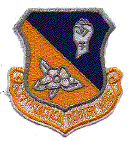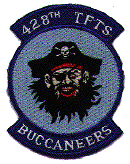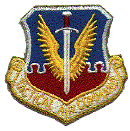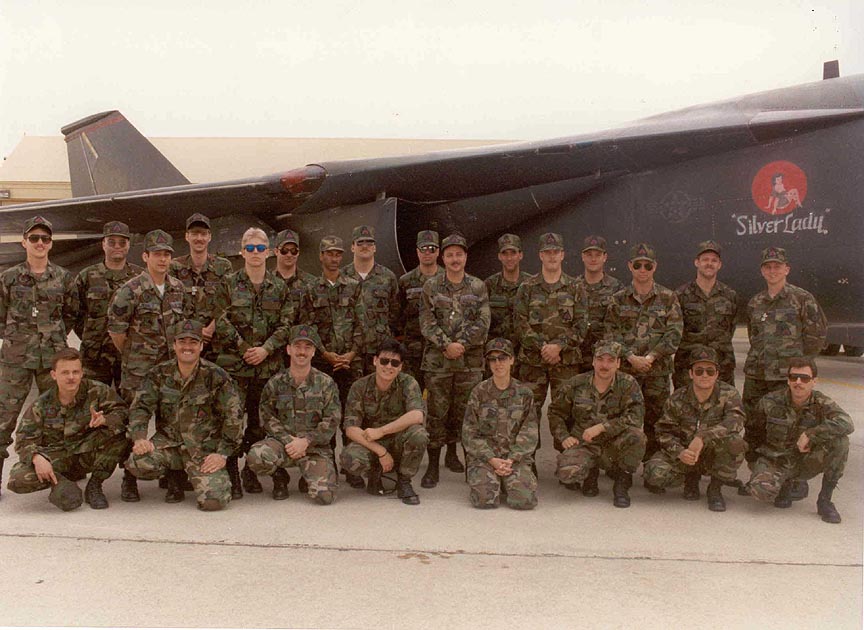


The 428th Fighter Squadron was created on May 28, 1943 and activated as a component of the 474th Fighter Group on August 1, 1943. Members of the squadron trained on P-38 "Lightning" and deployed overseas early 1944. First combat operations took place over France on April 25, 1944 and the squadron flew its last mission of the war in May 1945 before going back stateside and being deactivated on December 5, 1945.The 428th was reactivated for the Korean War as a Fighter-Bomber Squadron and assigned to the Tactical Air Command and Misawa AB, Japan in July 1952. However, the unit flew F-84s from Kunsan and Taegu AB in Korea. After leaving Korea in November 1954, the 428th reported to Clovis AFB, NM and flew F-86s and F-100s over New Mexico. The 428th TFS deployed to Homestead AFB, FL during the Cuban Missile Crisis.In 1964, the unit made its first trip to Vietnam and in the late 60s, moved with the 474th TFW to Nellis AFB, NV where they received the Air Force's newest plane, the F-111A and became the first fully operational unit with the type. In March 1968, Det.1 of the 428th TFS commanded by Col.Ivan H.Dethman deployed with six F-111A to Takhli, Royal Thai AB in Thailand under the code name "Combat Lancer". Following the loss of three aircraft due to internal problem and after 55 combat missions, the Det. returned to the United States in November 1968.From Nellis AFB, the 428th flew F-111A until 1975 when it converted to the F-4D. Another aircraft conversion took place in 1980 when training began on the F-16A. The 428th TFS was deactivated at Nellis AFB in the summer of 1989. The 428th Tactical Fighter Training Squadron was reactivated in April 1990 at Cannon AFB, NM to become the home for the F-111G to be used as RTU trainers in a purely conventional capacity. The first 'Gs' arrived in June 1990 and were flown until 1993 when replaced by former USAFE AMP F-111E.
The 31st Test and Evaluation Squadron was Strategic Air Command's representative in the world of flight testing. The squadron was tasked with monitoring and participating in the initial operational test and evaluation (IOT&E) conducted for SAC at Edwards AFB, CA. An assignment to the 31st was a special activity MAJCOM assignment and the squadron reported directly to Headquarters SAC under the Deputy Chief of Staff/Plans. In 1987, with over 90 officers and 300 enlisted personnel, the 31st was the largest initial operational test and evaluation squadron in the Air Force. While squadron members belonged administratively to the 31st, they were operationally committed to their specific test programs.The 31st TES took over the IOT&E reins from SAC's 4200th Test and Evaluation Squadron on July 1, 1986. The 4200th was deactivated and the former 31st Bombardment Squadron (H) was reactivated and redesignated by CINCSAC direction. The reason behind this action was that the former CINCSAC and current Air Force Chief of Staff, Gen.Larry Welch felt that it was critical for members of each SAC unit to have a rich combat heritage with which it could identify.The 31st Aero squadron of the Army Signal Corps was organized at Kelly Field, TX on June 26, 1917. This was to be the genesis of a long and prestigious history. The squadron served in France during World War I and it was there that the "skull and crossbones" were first placed upon a 31st Aero Squadron aircraft. The patch was officially approved in 1934 by the War Department. The squadron was reconstituted following the war and was subsequently deactivated and redesignated as a Bombardment Squadron on March 24, 1923. It remained on the inactive list until April 1, 1931 when the squadron was activated at March Field, CA. On February 1, 1938, the 31st left for Hickam Field, Hawaii and had all of its B-18s either damaged or destroyed during the December 7, 1941, Japanese attack on Pearl Harbor and Hickam Field. The squadron was soon back in the air with B-17s, tasked to support maritime bombing and surveillance missions. During 1943, the squadron converted to B-24s and continued bombing the Japanese into submission in the South Pacific. Serving throughout the Pacific after the war, the squadron was redesignated in October 1947 as the 31st Reconnaissance Squadron. The squadron flew B-29s and RB-29s, and was part of the Far Eastern Air Force. In late 1950, the 31st was moved back to the U.S. and placed under the 5th Strategic Recon Wing at Travis AFB, CA, where it began flying RB-36s in 1951. It converted completely to the B-36 by 1955 and was redesignated once again as the 31st Bombardment Squadron (H). The 31st accepted the Strategic Air Command's first B-52G in February 1959 and soon relocated to Beale AFB in early 1960. The squadron remained there until its deactivation in February 1963. Its proud lineage rested on the inactive list until July 1, 1966 when the squadron was reactivated at Edwards AFB, CA. The 31st task was to be the final inspection station before a strategic system was utilized. Its important mission was to make absolutely certain that SAC's new weapons systems were operationally suitable and effective.During 1982, Detachment 3, 4200th TES was tasked with FB-111A Simulator Test programs and Modification and Software Management at Plattsburgh and Pease AFB. It was one of three detachments for the 4200th TES in SAC located at a bombardment wing. The unit had ten people assigned, yet was responsible for simulator software management as well as for monitoring and administering civilian contracts for simulator modifications. The current contractor at the time was McDonnell Douglas Electronics Company, which was installing the ALR-62 Electronic Countermeasures System. The modification took approximately one year to complete. The detachment had many on-going software update projects for improved simulator training capabilities.
In August 1989, Strategic Air Command activated the Gen. Curtis E. LeMay Strategic Warfare Center (SWC) as the 99th Strategic Weapons Wing. Located at Ellsworth AFB, South Dakota, the wing was officially activated on August 10, 1989 with a simple purpose; to teach aircrews to get the most of their aircraft. When the SWC became fully operational in 1992, it consisted of six main activities; the tactics and intelligence directorates, the Strategic Training Center, the 1st Electronic Combat Range Group, and aircraft maintenance support. The SWC comprised three main branches. Tactics, previously taught at the SAC Tactics School at Nellis AFB, Nev., The Strategic Weapons School and the Strategic Training Center. Actual air training was conducted by the 25th Strategic Training Squadron. The squadron's main task was to design challenging scenarios for crews flying along the fourteen low-level training routes of the Strategic Training Route Complex (SRTC) and debrief crews to enhance their performance in weapons delivery and survivability. Crews deployed to Ellsworth AFB for training flew at least three sorties in the SRTC.FB-111A from the 380th and 509th BMW deployed alternately to the Strategic Training Center for a one-week period. Maintenance for the FBs was provided by maintainers deployed from Plattsburgh and Pease, and assigned to the 28th CAMS under the 28th BW. The 28th CAMS was responsible for maintaining the FB-111A and the B-52s deployed to the SWC while transient B-1B were handled by the 28th OMS. The 99th Strategic Weapons Wing became the 99th Tactics and Training Wing in 1993. In October 1995, the 99th was deactivated and was reformed as the 99th Air Base Wing at Nellis AFB, Nev.

Front row kneeling, from left to right: A1C Ivan Comlek-B shop, SSgt Steve Martinez-Crew Chief, SSgt ? Crew Chief, SRA Chuck Newman-C shop, TSgt Denise Weaver-Hydraulics, SSgt Al Longerbean-B shop, SSgt Glen Shaffer-Engines, TSgt Dan Collabelleta-Crew Chief.Back row standing, from left to right: SSgt Tim Riddel-B shop, TSgt Mike Fiedler-Engines, SSgt Dan Sennett-Crew Chief, SSgt Billy Hare-Crew Chief, SRA Vinne Stone-Crew Chief, SSgt Dave Hickling- Crew Chief, Sra Wes Patterson-Engines, SSgt Paul Howe-A shop, SSgt Larry St Denis- Crew Chief, TSgt Paul Kespert-B shop, SSgt Al Tapley-A shop, SSgt Rich Maskell-A shop, TSgt Scott Schweger-C Shop, TSgt Steve Walker-Crew Chief, MSgt Chip Cahoon-Crew Chief, SSgt Dean Foster-B shop. Not pictured: SSgt Bill Weaver-Crew Chief, SRA Jamie St Denis-ECS (Photo via Scott Schweger)
The arrival competition was among the more than 80 US and Canadian aircraft that came to "Survival 82". Each arriving aircraft overflew the base once and then returned for an approach and landing. All aircraft were judged on the quality of the overfly, the approach and the landing. Any violation of flight rules automatically disqualified the contestants. This was the first event the 380th BW participated in and the aviators received no advance notice of the arrival competition. The FB's crew won with 19 of the possible 20 points. The win came about as a result of a unique feature of the new low altitude training route. The new route, which was used to train bomber aircrews in navigation, bombing and fighter interception defensive procedures allowed for the simulated low altitude bombing of CFB Chatham.
Maj.Taylor Wilson and Capt. Gerald Blevins made a high-speed, low- altitude simulated bomb run on the air base as hundred of fellow aviators watched from the ground. During the attack, two CF-101B "Voodoos" completed their attack on the FB-111A and as the FB flew over the airfield, the "Voodoos" closed into perfect formation on each side to complete their practice 'identification check'. After passing the airfield, the FB climbed hard while the "Voodoos" veered away to the left and right. The FB proceeded into the visual pattern for a 'perfect' approach and landing. Their high speed attack received the only standing ovation from the aviators present for the competition."Survivors" from the 380th Bomb Wing were; Lt.Col. Dick Baumgartner, Maj. Robert Brenizer, Maj. Taylor Wilson, Maj. John Blewitt, Maj. A.G. Mason, Capt. Gerald Blevins, Capt. Kurt Klingenberger, Capt. Jim Miller, Capt. Randy Frantz, Capt. Tom Ekers, Capt .Keith Mathis, Capt. Xavier Villareal, SSgt. Mark Hoffman, SSgt. Howard Broudle, A1C Scott Clough and AB Stan Slovik who all received "Survivor" certificates.
An E-3 AWAC from Tinker AFB and 380th BW's KC-135s also participated as neutral. Ironman pitted FB-111A crews against various other fighters from around the Northeast. Flying missions over the Adirondacks and throughout New York, the bombers had three targets to reach on the Army's Fort Drum bombing range, near Watertown. Aircrews from the 528th and 529th Bomb Squadrons dropped Mk 106 practice weapons on ground targets. Meanwhile, the F-16 crews from Burlington, VT and Niagara Falls, NY gave chase to the FBs, trying to shoot them down during fighter intercept exercises. " An F-15 and F-16 turned circles around us. But we got down low, and tried to fake him out, beat him in his mind. We ran like hell and met our objectives. The CF-18s who escorted us tried to shoot down the F-16s before they nabbed us." said Capt. Shaun Sorenson, FB-111A pilot. When the bombers got to the range, they were welcome by the 62nd Air Defense Artillery Unit personnel using simulated surface-to-air missiles, trying to knock the bombers down. Communications were also jammed from the ground. After the mission, FB-111A were refueled by tankers from the 380th BW and returned home. For many FB crews, this was the last chance to prove their ability. "It will be sad to leave the flying community, " said Captain Sorenson. "It's my last chance to go out and 'fly' the jet. It's been a good airplane. It's reliable." Captain Pope expressed the same sentiment about losing the aircraft. "It's a bittersweet feeling knowing that a lot of flying careers are ending. It's good to see so much pride and professionalism displayed at the end." commented Pope. We want to stay sharp until the very end and even though we know we're not going to be utilized, it's a good feeling to have done this." he said.By July 10, 1991, the FB-111A era came to an end when the last FBs departed Plattsburgh AFB.
During two weeks in September 1989, 270 airmen from Plattsburgh Air Force Base set up operations in a small tent village constructed in a remote section of Seymour Johnson Air Force Base in North Carolina. Seven FB-111A and three KC-135s tankers based at Plattsburgh also deployed for the duration of the exercise. The benign occupation from Plattsburgh is just a small part of Mighty Warrior 1989, an 8th Air Force exercise designed to test the ability of Strategic Air Command units to operate under wartime conditions from locations far removed from their home bases. Mighty Warrior also involved aircraft and personnel from European bases as well as from every SAC base east of the Mississippi.
"This was not a competition, this was training," said Lt.Col. John Landon, commander of PAFB's 529th Bombardment Squadron. Landon, who commanded the PAFB detachment in North Carolina, said, "The reason we're going in was to train our air crews in doing a new job." The Plattsburgh personnel brought with them everything they needed to operate. They had the runways, they had the gas at Seymour Johnson. Otherwise it was an autonomous operation. We were operating from a part of the base not supported by Seymour-Johnson. During Mighty Warrior, Landon said, "The 8th Air Force would be sending us targets every day. We would get about 20 hours notice. They would call us up and say 'Your target today is this bridge.' They tell us where the target is and what time to hit it. Our planners then went into their documents and figured out how many weapons it would take to destroy that target and how close to the target they had to be. We developed our plans and decided how many planes we needed that day."
Landon said he was sending a mix of aircrews to North Carolina in order to take maximum advantage of the exercise's unique learning opportunities. "One-half was experienced and had been in this type of exercise before. I had other crews that were ready to take the next step in becoming more comfortable in dealing in fluid situations." Landon added his aircraft did fly in pairs against targets on weapons ranges around the country. " The two-plane formation paired up an experienced crew with one less experienced because within a year they will be my experienced guys.More than three months of work had gone into planning PAFB's participation in Mighty Warrior 1989. Landon said "But this was all great fun. The unit really came together and there was a real sense of purpose. This had involved every aspect of the base. It's exciting because it required you to be very flexible. there's so many things you can't control, like the weather, but it's a challenge to see if you can plan around them and still get the job done.After all the missions had been flown and Plattsburgh's personnel had returned home, Landon hoped "that everyone ended up with a better understanding of what our capabilities and liabilities are.